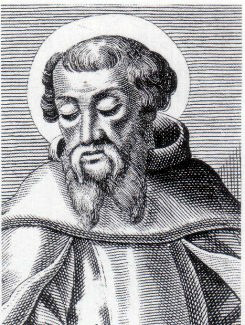[caption id="" align=“alignright” width=“125”]  Irenaeus of Lyons (Image via Wikipedia)[/caption]
Irenaeus of Lyons (Image via Wikipedia)[/caption]
In the third book of his work, Against Heresies, Irenaeus takes up a defense of the fourfold Gospel tradition. This defense proceeds as follows:
It is not possible that the Gospels can be either more or fewer in number than they are. For, since there are four zones of the world in which we live, and four principal winds, while the Church is scattered throughout all the world, and the “pillar and ground” [ 1 Tim. iii. 15] of the Church is the Gospel and the spirit of life; it is fitting that she should have four pillars, breathing out immortality on every side, and vivifying men afresh. . . . As also David says, when entreating His manifestation, “Thou that sittest between the cherubim, shine forth.” [ Ps. lxxx. 1] For the cherubim, too, were four-faced, and their faces were images of the dispensation of the Son of God. For, [as the Scripture] says, “The first living creature was like a lion,” [ Rev. iv. 7] symbolizing His effectual working, His leadership, and royal power; the second [living creature] was like a calf, signifying [His] sacrificial and sacerdotal order; but “the third had, as it were, the face as of a man,”—an evident description of His advent as a human being; “the fourth was like a flying eagle,” pointing out the gift of the Spirit hovering with His wings over the Church [ Irenaeus, Against Heresies 3.11.8 ( ANF 1:428)].
In the middle of this quotation, Irenaeus draws together the point to which he believes the fourfold Gospel tradition finally moves: “From which fact, it is evident that the Word, the Artificer of all, He that sitteth upon the cherubim, and contains [συνέχων] all things, He who was manifested to men, has given us the Gospel under four aspects, but bound together by one Spirit [ἑνὶ δὲ πνεύματι συνεχόμενον]” [ Irenaeus, Against Heresies 3.11.8 ( ANF 1:428; PG 7:885)]. For Irenaeus, therefore, the Spirit produced a theologically exclusive, fixed corpus that existed before that corpus became a formally recognized, sociological reality in the church.
In this post:
[caption id=“attachment_2148” align=“alignleft” width=“130”]  Alexander Roberts, James Donaldson, and A. Cleveland Cox[/caption]
Alexander Roberts, James Donaldson, and A. Cleveland Cox[/caption]
[caption id=“attachment_2014” align=“alignleft” width=“150”]  J. P. Migne[/caption]
J. P. Migne[/caption]